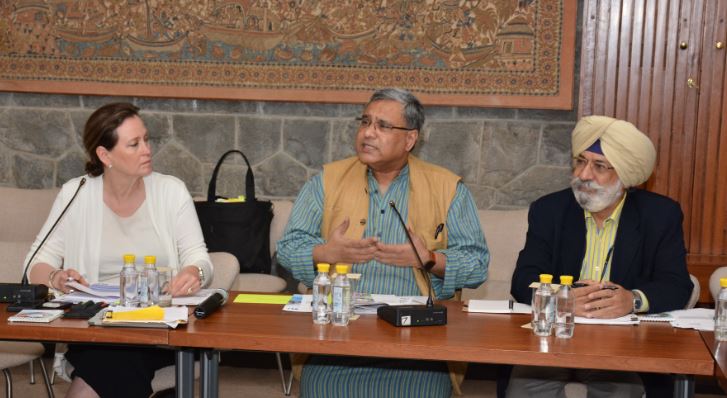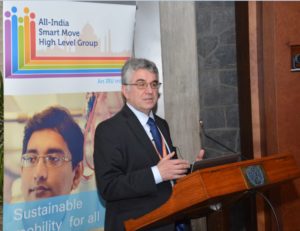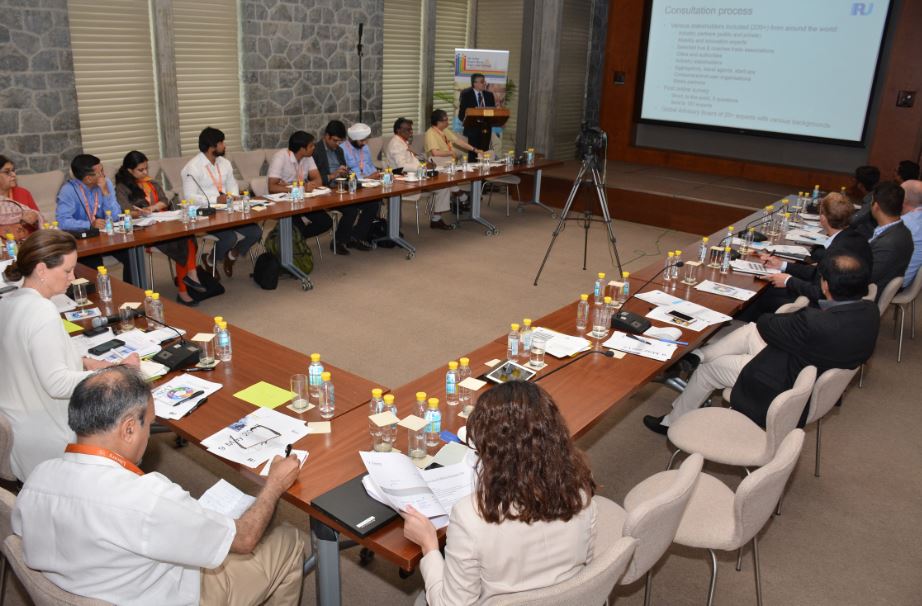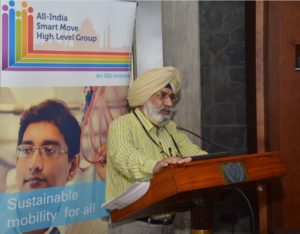All India Smart Move High Level Group Workshop pushes for a wider understanding of mobility for achieving Sustainable Development Goals 2030 (SDGs) and implementing the New Urban Agenda.
Making our mobility systems sustainable is a critical societal dilemma worldwide, with policy makers and industry stakeholders mulling over ways and means of addressing challenges of rising congestion and pollution, especially in urban centres. But that’s not all, fractured transport networks, unequitable access in non-urban areas, and the cultural aspects of mobility are also increasingly recognised. Our current thinking on global sustainable development is based on the realisation that any policy or business has to be ecologically sustainable and socially inclusive, thereby upholding environmental and social justice. This idea is reflected in some of the key documents that influence public policy across the globe, namely UN 2030 Agenda for Sustainable Development with 17 ‘Global Goals’ and 169 achievable targets, UNFCCC’s Paris Agreement (2015), the Habitat III New Urban Agenda that sets a new global standard for sustainable urban development, and the Sendai Framework for Disaster Risk Reduction 2015-2030 with seven targets and four priorities for action. Therefore, a fundamental rethinking on transportation policies and mobility systems is necessary, with inputs from all segments of society, incorporating technological innovation and infrastructure and land use changes, coupled with behavioural and cultural transformation.
“Making transport work better for communities in India and globally is a priority. The focus is on collective passenger services as the key to sustainable mobility that offers tremendous opportunities”, said Ms. Mary Crass, Head of Institutional Relations and Summit, International Transport Forum (ITF), pointing out the economic and social benefits that can help achieve SDGs, while moderating the All India Smart Move High Level Group Workshop “Mobility 2030: A Global Vision” on 9th May 2017 at New Delhi. She also emphasised on the role of collective door-to-door public transport in this regard, using buses, taxis, and intermediate public transport systems. Coordinated by IRU, the world’s road transport organisation, the workshop evoked discussion on a global vision on mobility for achieving SDGs and to implement the New Urban Agenda in India, focusing on major trends in general mobility and buses and taxi market in particular. Findings of some preliminary studies and initiatives in this regard were presented for discussions, along with debates on the sustainability of emerging and future scenarios likely in the transportation sector.
One such research document taken up for discussion at the workshop was “India Leaps Ahead: Transformative Mobility Solutions for All”, produced by NITI Aayog and Rocky Mountain Institute (RMI). Speaking on the report, Mr. Clay Stranger and Mr. Aman Chitkara of RMI outlined a shared, electric, and connected mobility future for India, with clean, affordable, cost-effective, and reliable transportation systems. IRU’s Head of Passenger Transport Mr. Oleg Kamberski presented the key findings of the study “Vision 2030 for Buses and coaches”, and said that transformation of mobility underpins innovation, new business models, and services. For instance, IRU is spearheading Mobility-as-a-service (MaaS) concept, together with new business models like Electric Taxis Lighthouse and UpTop, its global taxi network.
2030 Vision for Mobility in India
Speaking on the broader issue of mobility in the Indian context, Mr. Oleg Kamberski said that the primary challenge is to develop an efficient and reliable transport model, which is also affordable and accessible to all. On the similar lines, Dr. Kulwant Singh, coordinator, All India Smart Move High Level Group, added that transportation models in India lack in quality, quantity, and proper integration, resulting in a fractured network. He pointed out to the burgeoning rural-urban divide, stating that over 4,000 census towns are still out of urban mobility policy purview. Further, road transport is primarily a state subject, therefore centralized policy making hardly trickles down to the grass-root level in implementation. Absence of data on transport modes and their analytics is the next biggest hurdle. Data as an ‘asset’ in the mobility ecosystem remains unutilized in India. Therefore, the vision for future mobility must embrace a multi-pronged approach and well-defined goal on unhindered and equitable access to mobility in India.
Mr. B.N. Puri, Executive Director, Asian Institute of Transport Development (AITD) voiced for a new policy-making and administrative machinery for transport governance in India, something like a Ministry or a Department of ‘Transport Strategy’. He said that in the years to come, more of integration and consolidation of existing systems need higher priority than creating new systems. Capacity enhancement and advancement can follow suit, he added. Dr. Sanjay Gupta of School of Planning and Architecture also stressed on the need for an integrated planning of mobility solution in the coming decades. However, the elephant in the living room that is often ignored is the poor state of skill development and capacity building in public policy related to sustainable mobility. Dr. Kulwant Singh pointed out that there are only 12 transport planning schools in a vast country like India. Even in those institutions, the numbers of students and researchers are abysmal, he added, thereby making adverse impacts on strategic planning and policy making on sustainable mobility.
Vision into Reality: Strategies and Actions
“Vision for a sustainable mobility network in India should not lack relevance and targeted goals, as was the case in the past”, said Mr. Jaspal Singh, Head of UITP India Regional Office. As many experts believe, India is at a historic inflection point in global transportation, expecting paradigm shift in mobility over the next few decades. With a population of over 1.34 billion, India needs a well-integrated and transformative mobility system that is equitable and affordable, also efficient and sustainable. Rethinking of mobility should include all stakeholders, citizens, industry, business entities, governments, academia, etc. Technology is likely to be the key stakeholdersin this paradigm shift, but we must ensure that they are people-centric, thereby enabling innovation for sustainable development.
“The idea of mobility as a service is fast catching up”, said Mr. Ananda Rao, Executive Director, Association of State Road Transport Undertakings (ASRTU), pointing out that governments are realizing that they are funding not ‘buses’ but ‘mobility’, which is essentially a social good. Lastly, the role of ‘culture’ as an enabler in transformation of mobility can hardly be ignored. The mobility vision of most of the Scandinavian nations are based on its respective cultures. The vision of future mobility must recognize cultural aspirations on personal mobility in India and efforts should be initiated to engender behavioral change in the society. By this way, we can ensure that the process of visioning future mobility in India sits on the right track towards sustainable development, meeting human development goals and environmental stability.
“India Leaps Ahead: Transformative Mobility Solutions for All”
India’s national policy think tank National Institution for Transforming India (NITI Aayog) and Rocky Mountain Institute (RMI) have come up with specific and actionable solutions to transform India’s mobility sector. Based on inputs from 75 senior representatives from the Government of India, private sector, and civil society during the Transformative Mobility Solutions Charrette in February this year, the vision document outlines a set of actionable solutions to realize the vision, and estimates the impact of such a transformation.
Outlining a shared, electric, and connected mobility, the report envisages clean, affordable, cost-effective, and reliable transportation systems to support and enhance daily lives of the vast population of the country. The report reveals a “leapfrog” opportunity available for India to save as much as 1 gigatonne of carbon emissions between 2017 and 2030, and approximately INR 3.9 lakh crore (US$60 billion) in annual fuel import costs by 2030.
This translates to savings up to 64% of anticipated passenger mobility-related energy demand and 37% of carbon emissions in 2030 as against business as usual by pursuing a shared, electric, and connected mobility. Synergistic impact of improvements in systems, scaled manufacturing, and shared infrastructure, including better urban design, can help in this endeavour. This path of ‘mobility-led-development’ can enhance energy security, combat pollution, and create dynamic economic opportunities, says the report.



